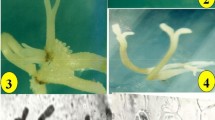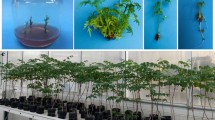Abstract
Background
In medicinal plants, selection, reproduction and preservation of important genotypes are very necessary. Nowadays, using tissue culture and regeneration techniques of medicinal plants under in vitro conditions has been able to proliferate medicinal plants widely, which is much higher than traditional methods of vegetative propagation. Maca (Lepidium meyenii), is an industrial plant whose root is the usable part. Maca has valuable medicinal effects such as sexual enhancement and reproductive power, infertility treatment, improved sperm count and quality, anti-stress, osteoporosis prevention and more.
Methods and results
This study was conducted to induce callus and regeneration of Maca. First, MS medium supplemented with different concentrations of Kinetin, Naphthaleneacetic acid and 2,4-Dichlorophenoxyacetic acid [0.5, 1 and 2 µM respectively] and control were compared for callus induction from root and leaves. After 38 days of incubation, the first callus appeared, after 50 days of callus induction and after 79 days regeneration occurred. The callus induction experiment was performed for the study of the effect of three explants (leaf, stem and root) and seven hormone levels. The regeneration experiment was carried out by studying the effect of three explants (leaf, stem and root) on eight levels of the hormone. The results of data analysis on callus induction showed that the effects of explants, hormones and their interactions on callus induction percentage were highly significant but not significant on callus growth rate. The results of regression analysis showed that explants, hormones and their interactions had no significant effect on regeneration percentage.
Conclusion
Based on our results, the best medium for inducing callus was Hormone 2,4-D [2 µM] and Kinetin [0.5 µM], in which the highest percentage of callus induction was in leaf explants (62%). And the lowest were in stem (30%) and root (27%) explants. According to the comparison of the mean, the best environment for regeneration of the environment was 4 µM 6-Benzylaminopurine 2.5 + Thidiazuron, in which the highest percentage of regeneration was in leaf explant (87%) and stem (69%) and the lowest in root explant (12). %).





Similar content being viewed by others
References
Almasi F (2021) Organic Fertilizer Effects on morphological and biochemical traits and yield in Coriander (Coriandrum sativum L.) as an Industrial and Medicinal Plant. Agrotechniques in Industrial Crops 1(1):19–23
Shaafi B et al (2021) The optimized protocols for production, adaptation and keeping of the produced Artificial Seeds from Encapsulated lateral buds in Stevia rebaudiana (Bertoni). Agrotechniques in Industrial Crops 1(1):24–35
Norouzi Y et al (2021) Effect of Nitrogen and Cytokinin on quantitative and qualitative yield of thyme (Thymus vulgaris L.). Agrotechniques in Industrial Crops 1(1):52–60
Omidbaigi R (2005) Production and processing of medicinal plants. Beh-Nashr: Mashhad, : p.210–225
Gonzales G (2007) Biological effects of Lepidium meyenii, maca, a plant from the highlands of Peru Natural products I, : p. 209–234
Osuna L et al (2006) Micropropagation of Lepidium virginicum (Brassicaceae), a plant with antiprotozoal activity. In Vitro Cellular & Developmental Biology-Plant, 42(6): p. 596–600
Meissner HO et al (2019) Glucosinolates profiles in Maca phenotypes cultivated in Peru and China (Lepidium peruvianum syn. L. meyenii). Phytochem Lett 31:208–216
Zhang J et al (2016) Genome of plant maca (Lepidium meyenii) illuminates genomic basis for high-altitude adaptation in the central Andes. Mol Plant 9(7):1066–1077
Lin L et al (2018) Maca (Lepidium meyenii) as a source of macamides and polysaccharide in combating of oxidative stress and damage in human erythrocytes. Int J Food Sci Technol 53(2):304–312
Tang W et al (2017) Structural characterization and antifatigue effect in vivo of maca (Lepidium meyenii Walp) polysaccharide. J Food Sci 82(3):757–764
Dini A et al (1994) Chemical composition of Lepidium meyenii. Food Chem 49(4):347–349
Jagdale YD et al (2021) Nutritional Profile and potential health benefits of Super Foods: a review. Sustainability 13(16):9240
McCollom MM et al (2005) Analysis of macamides in samples of Maca (Lepidium meyenii) by HPLC-UV‐MS/MS. Phytochemical Analysis: An International Journal of Plant Chemical and Biochemical Techniques 16(6):463–469
Wang S, Zhu F (2019) Chemical composition and health effects of maca (Lepidium meyenii). Food Chem 288:422–443
Quandt P, Puga M (2016) Manic episode secondary to maca. Eur Psychiatry 33(S1):S339–S339
Kang C et al (2016) Response Surface Methodology Optimization Extraction of Polysaccharides from Maca (Lepidium meyenii) Leaves and Primary Characterization. In International Conference on Applied Biotechnology. Springer
Rubio J et al (2011) Dose–response effect of black maca (Lepidium meyenii) in mice with memory impairment induced by ethanol. Toxicol Mech Methods 21(8):628–634
Gonzales GF, Gasco M, Lozada-Requena I (2013) Role of maca (Lepidium meyenii) consumption on serum interleukin-6 levels and health status in populations living in the peruvian Central Andes over 4000 m of altitude. Plant Foods Hum Nutr 68(4):347–351
Onaolapo A, Oladipo B, Onaolapo O (2018) Cyclophosphamide-induced male subfertility in mice: an assessment of the potential benefits of Maca supplement. Andrologia 50(3):e12911
Lembè DM, Gasco M, Gonzales GF (2012) Fertility and estrogenic activity of Turraeanthus africanus in combination with Lepidium meyenii (Black maca) in female mice. Eur J Integr Med 4(3):e345–e351
Del Prete C et al (2018) Influences of dietary supplementation with Lepidium meyenii (Maca) on stallion sperm production and on preservation of sperm quality during storage at 5 C. Andrology 6(2):351–361
Li J et al (2017) Anti-fatigue activity of polysaccharide fractions from Lepidium meyenii Walp.(maca). Int J Biol Macromol 95:1305–1311
Mahmood Q et al (2017) Phytochemical and biological assessments on Lipidium meyenii [maca] and Epimidium sagittatum [horny goat weed]
Chen L, Li J, Fan L (2017) The nutritional composition of maca in hypocotyls (Lepidium meyenii Walp.) cultivated in different regions of China Journal of Food Quality, 2017
Jin W et al (2018) Aerial parts of maca (Lepidium meyenii Walp.) As functional vegetables with gastrointestinal prokinetic efficacy in vivo, vol 9. Food & function, pp 3456–3465. 6
Espinosa-Leal CA, Puente-Garza CA (2018) and S. García-Lara, In vitro plant tissue culture: means for production of biological active compounds Planta, 248(1): p. 1–18
Kahrizi D et al (2012) Medicinal plants in holy Quran. Am J Sci Res 42:62–71
Pande D, Iqbal M, Srivastava P (2000) Effect of ZnSO4 and CuSO4 on regeneration and lepidine content in Lepidium sativum L. Biol Plant 43(2):253–256
Naqvi SSM (2001) Plant growth hormones: growth promoters and inhibitors, in Handbook of plant and crop physiology. CRC Press, pp 523–548
Guo BJ, Schieder O (1983) Callus and root formation from mesophyll protoplasts of chinese cabbage (Brassica chinensis L.). Z für Pflanzenphysiologie 110(4):375–377
Arshad M (2009) Lead phytoextraction by scented Pelargonium cultivars: Soil-plant interactions and tool development for understanding lead hyperaccumulation.
LEBEDA A, DOLEŽALOVÁ I, VALENTOVÁ K (2003) Biologická a chemická variabilita maky a jakonu. Chemické listy 7:548–601
Acknowledgements
We would like to thank Razi University for providing the facilities for this research.
Author information
Authors and Affiliations
Contributions
Atefeh Fahimi Far, Zeinab Chaghakaboodi, Mozafar Khazaei: Execution research project, Experimental design, Data analysis, Manuscript preparation.
Danial Kahrizi, Esra Ucar Sozmen, Hulya Dogan: Experimental design, Data analysis, Manuscript preparation.
Corresponding author
Ethics declarations
Conflict of Interest
Danial Kahrizi, Atefeh Fahimi Far, Zeinab Chaghakaboodi, Mozafar Khazaei, Esra Ucar Sozmen and Hulya Dogan declare that she does not have a conflict of interest. Danial Kahrizi declares that he does not have a conflict of interest.
Ethical approval
This study was approved by the Ethics Committee of Razi University, Kermanshah, Iran.
Additional information
Publisher’s Note
Springer Nature remains neutral with regard to jurisdictional claims in published maps and institutional affiliations.
Rights and permissions
Springer Nature or its licensor (e.g. a society or other partner) holds exclusive rights to this article under a publishing agreement with the author(s) or other rightsholder(s); author self-archiving of the accepted manuscript version of this article is solely governed by the terms of such publishing agreement and applicable law.
About this article
Cite this article
Kahrizi, D., Far, A.F., Chaghakaboodi, Z. et al. Stem cell induction and plant regeneration are affected by medium components in maca (Lepidium meyenii Walp). Mol Biol Rep 50, 4187–4192 (2023). https://doi.org/10.1007/s11033-023-08319-2
Received:
Accepted:
Published:
Issue Date:
DOI: https://doi.org/10.1007/s11033-023-08319-2




